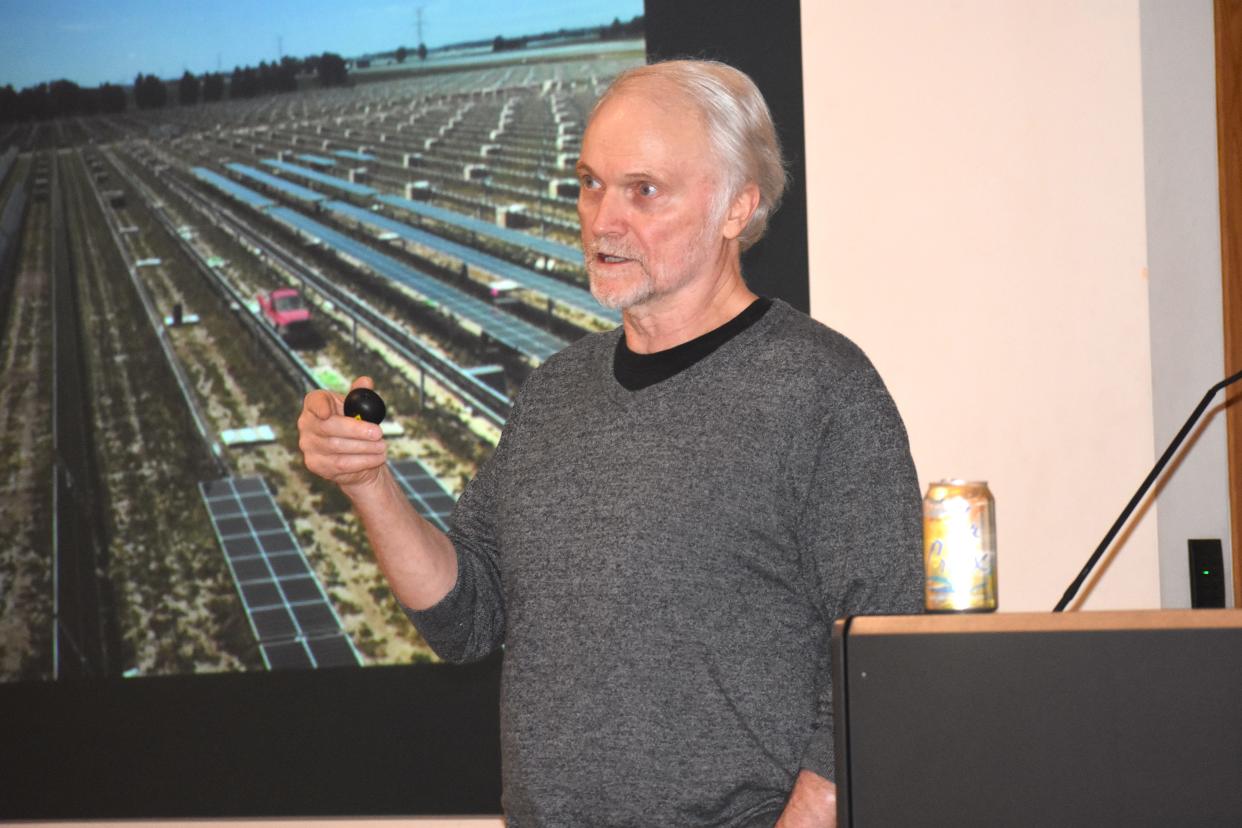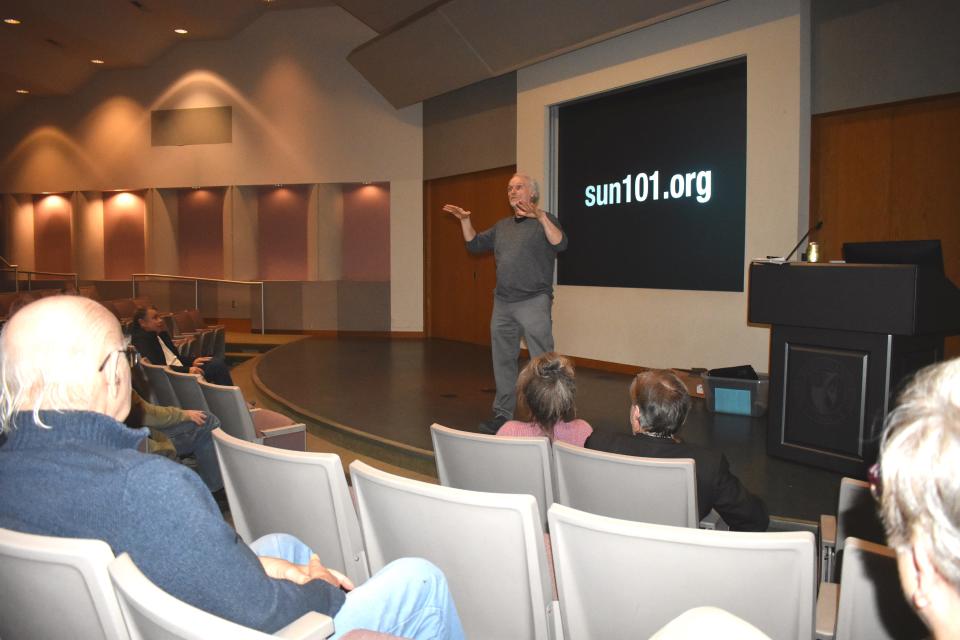'Sun 101' presentation at Siena Heights examines the benefits of green energy

ADRIAN — Scientists and professors, researchers and municipal leaders from throughout Michigan provided a broad look at the positives of both solar and wind energy during a multimedia presentation at Siena Heights University.
The “Sun 101” presentation was conducted by Peter Sinclair, a Michigan-based videographer specializing in energy and environment. What he described as a “video-rich” presentation sought to provide answers to the most common questions regarding clean energy and other sources of renewable energy.
His presentation, he added, also aimed to debunk misinformation regarding clean energy.
Sinclair, of Midland, presented May 4 at the university at the invitation of Siena Heights’ Sustainable College Committee, which is chaired by Thomas Wassmer, associate professor of biology at SHU. Nearly 30 people attended the presentation in Rueckert Auditorium in Dominican Hall.
Wassmer, when introducing Sinclair, said the main forms of renewable energy — solar and wind energy — are the key ingredients for Michigan and the country to get away from relying on fossil fuels as the main source of energy.
Sinclair, whose focus as an activist is on climate change, has traveled around the globe to various “hot spots” of climate change, including Antartica and Greenland, where he assisted in documenting the melting surface of Greenland as part of the Dark Snow Project. In 2017, the National Center for Science Education named him Friend of the Planet.
“What has made me most proud of is that I developed a following in the scientific community,” he said. “And about 10 years ago, (scientists and researchers) started inviting me out into the field, to places where they do their work, and I've been embedded with them.”
When conducting interviews about climate change and renewable energy, Sinclair said he goes to the most trusted sources: scientists, professors and researchers in the field who are following and recording data.
“The scientists have really become my mentors, my teachers. They challenge me, and I challenge them,” he said. “And so, over the last dozen years, I have interviewed hundreds, probably more than 1,000 scientists and engineers who are at the top of their fields, across Europe, America and Asia. I feel like I've been able to translate what it is they're trying to tell us.”
A Michigan State University poll that was conducted a few years ago, he said, found a large majority of people generally support moving away from fossil fuels and toward solar and wind energy..
Sinclair referenced the Wall Street Journal from at least three years ago, which stated wind and solar energy represents the lowest cost options for generating electricity. The cost for solar, he added, has come down dramatically over the past 10 years.

As long as America continues to rely on fossil fuels, including natural gas, as its main source of energy, Sinclair said the country will be “held hostage, as long as we are dependent on resources that are finite and limited in quantity or geographically.”
The price of natural gas is “skyrocketing” in the United States, he said, and is “completely off the chart” in European nations.
Wolfgang Bauer, a Michigan State University professor of physics and astronomy who was one of several experts Sinclair interviewed for his video presentation, said “it’s significantly cheaper” to deploy solar resources at this time.
Other researchers and professors Sinclair interviewed included Josh Pearce, an academic engineer at the University of Western Ontario and Michigan Technological University; Tommy Cleveland, a solar photovoltaic engineer with Advanced Energy; and Daniel Cohan, associate professor of civil and environmental engineering at Rice University in Houston.
Adrian College associate professor of biology Jeffrey Lake was briefly featured during Sinclair's presentation.
Sinclair provided a video clip from a solar facility operated by the University of Illinois. The one-minute clip began at a distance of 1,000 feet away from the facility and gradually throughout the video moved closer. The objective of the video, he said, was to show the public what such a solar project looks like and how it contains no moving parts, does not produce loud or obnoxious noises from its converters, and is surrounded by grasslands. Showing the video clip, he said, was a method to debunk the misinformation on social media about the appearances and impacts of solar facilities.
“That is not the picture that is going out in social media that a lot of people follow quite enthusiastically,” he said. “And we have some leaders in the anticlean energy movement here in the local area.
“… A lot of people are getting a very distorted picture, and those of us that have been following the difference between Facebook reality and real reality over the last few years have noticed a divergence. There are some bad actors out there who are actively spreading misinformation, and they have loyal followers.”
Misinformation strikes at the heart of democracy, he said.
“We have a very serious problem with bad actors spreading misinformation and deliberately trying to create conflict in communities,” he said. “And some of these actors are even on the other side of the world.”
Big “titan” companies such as Walmart, Google and General Motors, Sinclair said, are becoming some of the biggest buyers of renewable energy. GM, in a video clip, said it plans to receive all of its power from clean energy sources by 2050.
Patricia McGarr, the national director of valuation for the accounting firm CohnReznick, who specializes in real estate valuation, said after beginning in 2017 and conducting 26 studies in 15 different states, statistics have “consistently shown that there is no consistent measurable negative impact” of solar facilities that are adjacent to properties. At least 50-60 assessors of large-scale solar facilities across the country, who have been interviewed by McGarr’s team of real estate appraisers, have not recorded “any negative impact” to the property value of adjacent homes.
In Michigan, Sinclair said he visited solar farms in Lapeer, as well as the Assembly Solar Farm in Shiawassee County, which at 1,200 acres is the largest solar operation in Michigan and includes nearly 800,000 bifacial solar modules. Researchers studying these two facilities have found no negative impacts from their existence, according to Sinclair’s presentation.
“The really cool thing about solar and wind is you know when the sun is going to come out,” Sinclair said. “You know when it is going to be cloudy. You know when there is going to be wind, actually, with incredible accuracy.”
Because of the predictability of the sun, clouds, wind and other weather, Sinclair said, power engineers “really like green sources of energy” because of their predictability.
By 2040, Consumers Energy, he said, has projected to have solar facilities on 40,000 acres of farmland in the state. He said that sounds like quite a bit until one looks at the state’s overall number of farmland acres, which amounts to 10 million.
In comparison, he added, there are currently 97,500 acres of land in the state utilized by golf courses. Cornfields, many of which grow corn to be used for ethanol, total about 2,350,000 acres in Michigan, Sinclair said, with that acreage number varying year to year.
“If we’re interested in saving farmland, what we should probably do is figure out a way to save farmers,” he said.
To lend a helping hand to the farming and agricultural community, Sinclair suggested providing farmers the means and ways to diversify their income, which, he said, “renewable energy does beautifully.”
“I grew up in Michigan that was leading the world in technology and manufacturing, and I think we should lead in those categories again,” he said. “The only reason we don’t is because the political will has been lacking. I would like to see that happen again, and we can do it through renewable energy. We have everything that we need.”
Sinclair can be followed online at www.sun101.org and at www.wind101.info. Those in attendance were provided with several documents and studies regarding solar energy systems. Provided documents were generated from Michigan State University Extension, North Carolina State University, the University of Michigan Graham Sustainability Institute, and the Michigan Department of Environment, Great Lakes and Energy.
All of the information included in Sinclair's presentation can be found at his websites. The information, he said, should be shared on social media as much as possible, “as a remedy to the misinformation out there."
This article originally appeared on The Daily Telegram: Siena Heights' 'Sun 101' program discusses green energy concepts

